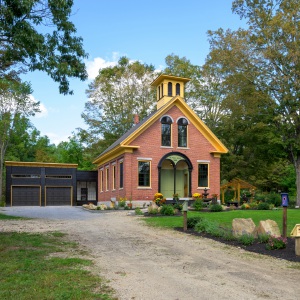There are still New Hampshire homes that heat with coal. Yes, coal
| Published: 05-21-2021 5:57 PM |
Coal, once the dominant fuel for heating buildings while driving industry in New England, has faded almost entirely from view. Julie Kinney can point to one remnant that she wishes would fade with it.
“We have an ash pile right now. At some point we’ll have to talk with whoever moves here, how to get rid of it,” said Kinney.
For years Kinney, of Derry, has been part of the small segment of New Hampshire residents – small and getting smaller – who heat their home with coal, burned in small stoves or a boiler. She chose a pellet coal stove in 2005 for the same reason that it fueled the Industrial Revolution and heated a majority of American homes through World War II: It’s powerful stuff, packing more energy than almost anything this side of uranium.
“The BTUs are incredible,” Kinney said, using the acronym of British Thermal Unit, a measure of energy output. “I could heat my house all winter for about $1,000 and walk around in my knickers if I want to.”
Just ask Harris Energy in Littleton, which provides coal for heating to some 250 customers throughout New Hampshire and Vermont, some as far as 100 miles away.
“They are very glad they have it because of the amount of heat they put out,” said owner Carroll Lucas. “They say, ‘it’s a little more work but I keep my house at 75 instead of 65.’ ” He said it takes about 1.7 tons of pellets to equal a ton of coal in terms of heating output.
But coal has a serious weakness: It’s dirty stuff. Burning coal for power and industry is a major source of the greenhouse gases that are warping the climate, and there’s the pollution closer to hand as shown by Kinney’s ash pile. Burning coal pellets leaves behind 20% to 30% of their weight in ash, at least 10 times the amount that’s left by wood pellets.
“When you empty the ash bucket you’re like, ‘Oh boy, I shouldn’t have dusted’,” said Kinney. This is her last winter with coal; she’s about to switch to propane.
Article continues after...
Yesterday's Most Read Articles
 Bill to allow ‘no fault’ evictions makes it to governor’s desk
Bill to allow ‘no fault’ evictions makes it to governor’s desk
 ‘He’s coming home’: Jury acquits former prison guard Matthew Millar in murder trial
‘He’s coming home’: Jury acquits former prison guard Matthew Millar in murder trial
 Look, up in the sky! It’s… an Airstream trailer?
Look, up in the sky! It’s… an Airstream trailer?
 Around Concord: Living in an 1856 schoolhouse is (mostly) delightful
Around Concord: Living in an 1856 schoolhouse is (mostly) delightful
 Slots and no bet limits: State budget shakes up New Hampshire’s casino landscape
Slots and no bet limits: State budget shakes up New Hampshire’s casino landscape
 ‘Deep flavor’ – New restaurant in downtown Concord offers creative spin on comfort food and cocktails
‘Deep flavor’ – New restaurant in downtown Concord offers creative spin on comfort food and cocktails
Coal was once a major source of home heating in New Hampshire. As late as 1940 the U.S. census says 34.8% of state homes used it. Home coal use was just as common throughout much of the U.S., not to mention overseas: London homes burned so much coal that they created the infamous “London fog” until the Great Smog of 1952 killed hundreds and led to that country’s clean-air laws.
In New Hampshire, it was oil and electricity, and then natural gas, that pushed out coal. State officials estimate about 611 homes in New Hampshire heat primarily with coal, about one-ninth of one percent of all houses in the state.
Coal in New Hampshire is now associated with Merrimack Station in Bow, which burns thousands of tons of it as the last coal-fired power plant in New England. Fewer companies even make the stoves – Vermont Castings, for example, dropped its model years ago – and few stores sell them.
“The demand was very limited,” said Paul Barlett, a sales associate since 1979 at the Stove Shoppe in Windham, on why they stopped selling coal stoves a few years ago. It wasn’t always that way, he said.
“In the early 80s, every Monday night I used to do a coal-burning class, because we’d sell 50-60 coal stoves a week,” he said. The class reflected a complication with coal stoves: They take effort. “It would take a couple hour class on how to burn it, fill it, how to empty the ash – don’t throw it in your garden, it can’t be used like that – how to detect carbon monoxide (problems).”
Indeed, coal ash can be toxic. Its disposal is one of the major problems with burning the fuel in any amount.
Plus, if you do have a stove, finding coal isn’t easy since few stores stock the 40-pound bags of anthracite coal in sizes known as rice, pea and nut, or deliver it to homes with furnaces. (Anthracite is the least dirty of all types of coal to turn, and long ago replaced cheaper but dirtier bituminous coal in homes.)
One of the few places where coal remains a healthy part of the business is Harris Energy in Littleton, which also provides oil and wood for heating.
“We started as a truck a year. We’ve grown to (provide) between 300 and 500 tons of it a year. Maybe 250 customers,” said owner Lucas. To put that number in context, the company has about five times as many customers who burn wood pellets as supplemental heat or a main heating source, but he sells almost 10 times as many pounds of wood pellets.
Lucas added coal to the company’s mix of products when he bought it in 2006 after working there a half-dozen years. He knew there was enough business in the North Country, where natural gas pipelines haven’t arrived.
“Some people have a coal stove or boiler in their house from 40-50 years ago. Some people got it back maybe 5 or 6 years ago, when (wood) pellet stoves were so popular that manufacturers couldn’t keep up with demand. They wanted to get away from oil because of high prices,” he said.
There’s no sign of the interest going away, he said.
Things are slightly different across the Connecticut River, where coal heat is just as rare: A UNH survey of Vermont in 2019 found only 529 homes heated in the state that heated primarily with coal and 402 that had it as a second source.
Vermont is trying to reduce that number through the coal change-out program run through its Vermont Small Scale Renewable Energy Incentive Program. It pays up to $7,000 for homes and $27,000 for businesses to switch from burning coal to burning wood. Launched last July with $300,000, it is set to run out next month unless it is extended further from the Clean Energy Development Fund. It has overseen 10 change-outs, said Suzanne Elowson, the manager for the state’s Renewable Energy Rescource Center.
David Frank, co-owner of Sunwood Biomass in Vergennes, Vermont, has performed a few of the change-outs. Customer reasons have been varied. Concern about climate change is part of it, since coal is the worst fuel source from the point of view of greenhouse gases, but practical considerations hold sway.
“A common thread is about coal being dirty and they’re tired of handling it. And frankly, availability has become a problem,” he said. “Really, it’s hard to imagine using coal up here. That’s a long way to bring it.”
In Littleton, Lucas says climate change isn’t much of a factor in people’s decision about whether to burn coal.
“I’ve never heard it from a customer up here. I’ve never had a customer say, ‘I love it, but I hate the environmental impact of it,’” he said.
In the big picture, the environmental impact isn’t terribly important. The Merrimack Station power plant in Bow burned about half a million tons of coal in 2018, which is more than 1,000 times as much as all of New Hampshire’s coal-using homes combined. If every one of those homes switched from coal tomorrow it wouldn’t even be a rounding error in climate-change statistics.
That’s no reason not to make the switch, however. Scientists agree that the sooner we stop burning fossil fuels for whatever reason, the less we’ll have to cope with generations of planetary damage. Even if it’s not a major benefit, it’s a benefit. Although, like many environmental choices, it carries a little cost.
“I’ll miss that heat,” admitted Kinney.
(David Brooks can be reached at 369-3313 or dbrooks@cmonitor.com or on Twitter @GraniteGeek.)]]>







 Celebrating independence: A list of local July 4 celebrations
Celebrating independence: A list of local July 4 celebrations Around Concord: Over The Moon Farmstead brings mead, beer, pizza and music to Pittsfield
Around Concord: Over The Moon Farmstead brings mead, beer, pizza and music to Pittsfield Around Concord: The Balshaws bring a rustic revival to the Canterbury Country Store
Around Concord: The Balshaws bring a rustic revival to the Canterbury Country Store
